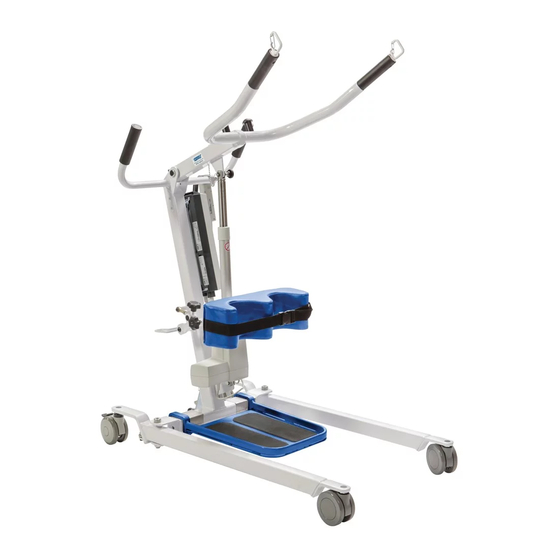Direct Supply ATLAS Owner's Manual - Page 10
Browse online or download pdf Owner's Manual for Medical Equipment Direct Supply ATLAS. Direct Supply ATLAS 17 pages. Sit-to-stand lift

Lifting the Resident
WARNING: Warning indicates a potentially hazardous situation which, if not avoided, could result
in death or serious injury.
How to Operate the Sit-to-Stand Resident Lift: (Weight Lifting
Capacity: 400 lbs.)
NOTE: Prior to fi rst use, please make sure the battery has been charged for 24 hours in order to
reach proper function and prolong the battery life.
CAUTION: More than one assistant is recommended for all resident lift activities.
Positioning the Sit-to-Stand Resident Lift
WARNING: When lifting a resident, the legs of the lift must be in the maximum open position
for stability. If it is necessary to close the legs of the lift to maneuver the lift under a bed, close the
legs of the lift only as long as it takes to position the lift over the resident and lift the resident off the
surface of the bed. Return the legs of the lift to the maximum open position when the legs of the lift
are no longer under the bed, and lock the shifter handle.
NOTE: Before positioning the legs of the resident lift under a bed, make sure the area is clear of any
obstructions.
a) Use spreader adjustment handle (right to left) to open the legs of the resident lift to
maximum width.
b) Use the steering handle to position the resident lift.
c) To lower the boom for easy attachment of the sling, press the down button on the
hand control.
Raise
WARNING: The legs of the lift must be in the maximum open position for optimum stability. If it is
necessary to close the legs of the lift to maneuver the lift under a bed, close the legs of the lift only
as long as it takes to position the lift over the resident and lift the resident off the surface of the bed.
When the legs of the lift are no longer under the bed, return the legs of the lift to the maximum open
position, and lock the shifter handle immediately.
18
Lower
Lifting/Moving the Resident
WARNING: DO NOT exceed the maximum weight limitation of 400 lbs. Individuals that use the standing
resident sling MUST be able to support the majority of their own weight; otherwise, injury may occur.
WARNING: DO NOT move the resident if the sling is not properly attached to the attachment
points on the sit-to-stand lift. Make sure the sling is properly attached BEFORE lifting the resident.
If any attachments are not properly in place, correct the problem. When the sling is elevated a few
inches off the stationary surface, and before moving the resident, check again to make sure the
sling and all attachments are securely in place. If any problem is found, lower the resident back
onto the stationary surface and correct the problem to avoid injury or damage. Damage may occur.
Adjustments for safety and comfort should be made before moving the resident. Direct Supply
resident slings are made specifi cally for use with Direct Supply resident lifts. For the resident safety,
DO NOT intermix resident slings and resident lifts of other manufacturers.
NOTE: First, ensure the resident is in a seated position. Use the head section of the bed to get the
resident upright, then move legs over the side of the bed.
Attaching a Sling
WARNING: Standing slings – the bottom edge of the standing sling must be positioned on the
resident's lower back with arms outside the sling before lifting the resident.
WARNING: Transfer slings – the bottom edge of the transfer sling must be positioned at the base
of the spine with the resident's arms outside the sling before lifting the resident.
Direct Supply does not recommend locking the rear casters of the sit-to-stand lift when lifting and
transferring an individual. This could cause the lift to tip and injure the resident and assistants. Direct
Supply recommends the rear casters to be left unlocked during lifting and transferring procedures to
allow the sit-to-stand lift to stabilize itself when the resident is initially lifted from and transferred to a
chair, bed or any stationary object.
Sling Attachment Guidelines
a) Place the sit-to-stand sling around the resident according to the vest's instruction guide.
b) Place sit-to-stand lift in front of the resident, and adjust the width of the base.
c) Place the feet in the middle of the footrest with the lower legs parallel to the lower leg support.
d) Adjust the height and depth of the lower leg support as needed for comfortable support below
the kneecap.
e) Connect the sling straps to the boom/lift arm's hooks. There may be multiple loops on the sling
that can be hooked to the boom/lift arm's attachment hooks to properly position the sling for
maximum stability and comfort.
f) Raise the sling bar about 4 to 8 inches, and have the resident grab the sling bar for support.
Then continue the lifting procedure.
g) If the resident leans backwards, raising the resident will be made easier, preventing the vest
from sliding up. The height to which the lift should reach varies from person to person.
h) Before the resident is lifted from the underlying surface, but after the straps have been fully
extended, ensure the straps are properly connected to the sling bar.
i) For a more upright position, continue the lifting motion to the uppermost position. The raising
motion can be experienced as unpleasant for the person not used to it.
19
1-800-634-7328
DirectSupply.com
